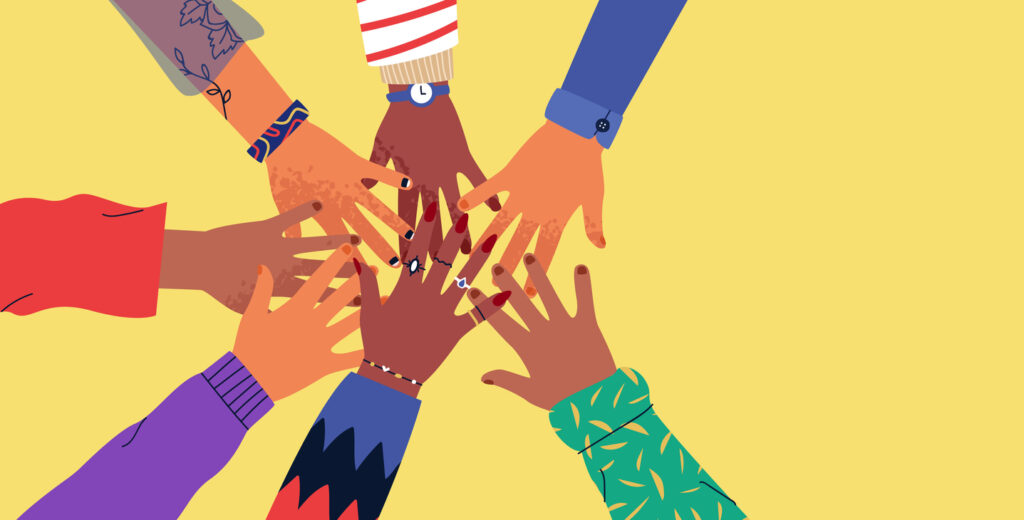It’s a cliché – but surely a truth too – that teams are most effective when the collective effort is greater than the sum of its parts. So why is this such a difficult ideal to live up to? How do you actually go about building this mysterious ‘team cohesion’? That’s what we’ll explore here.
What stops teams working well together, and how can you change that? There are of course many layers to this, just as there are many layers of complexity within any team, system or organisation. Therein lies part of the answer: complexity and pressure can prevent both individuals and groups from operating most efficiently.
The first crucial step to building team cohesion is simply to create the conditions – time, space and encouragement – for people to fully express themselves and to deeply hear each other.
The world of work is becoming ever more complicated and pressurised, and as a result some teams may be functioning but not flourishing. There may be blocks in the system – the team or wider organisation – causing inefficiencies, low morale, or a lack of clear vision and direction. There may be conflicting demands, hidden agendas, clashing personalities, and so on.
Einstein warned that we cannot solve our problems with the same thinking we used when we created them. This is highly apt here. The strong temptation when teams get stuck is to try to solve this systemic complexity with more complexity – analysing where those blocks or inefficiencies are, which relationships are most toxic, and so on. While such considerations inevitably have their place, they can sometimes cloud the original problem (and its solution). It’s very often simply about setting up the flow of communication and mutual understanding.
Developing emotional intelligence
The first crucial step to building team cohesion is simply to create the conditions – time, space and encouragement – for people to fully express themselves and to deeply hear each other. Surprisingly often this is more than enough on its own. It’s the foundation on which effective systemic strategies and solutions are built.
Here we’re in the realm of emotional intelligence (EQ). Put simply, EQ is about understanding and being comfortable with the emotional landscape of both yourself and those around you. When people master these skills, they can really hear and ‘get’ other people – their true motivations, preferences, and challenges – and use this knowledge to make good decisions in everyone’s best interests.
In teams, the best conditions are a culture and atmosphere of ‘mutual facilitation’ – where everyone feels comfortable in giving others the space to think clearly and creatively.
The best way for both teams and individuals to train in EQ – and therefore to cultivate true team cohesion – is through a combination of two complementary approaches. First, as any team is a collection of individuals, we must always start with the individual – developing deep awareness of self and other, through tried-and tested mindfulness-based processes. In our programmes, we use a simple ABC mindfulness model for this:
- Awareness – of one’s mental and physical experience.
- Being with experience – creating space to deal with intractable problems and challenging emotions.
- Choosing wisely – by responding flexibly instead of reacting automatically.
Ultimately, this is about every team member becoming more psychologically flexible and resilient, opening up the full range of choices available in any given situation. This equips and prepares everyone best for developing healthy relations with others.
Four steps to better communication
Building on this, the second complementary approach is the ‘co-active’ model of relationship and communication. This is based on the core truth that we all have deep natural resources for collaborative problem solving, when the right conditions are in place.
In teams, the best conditions are a culture and atmosphere of ‘mutual facilitation’ – where everyone feels comfortable in giving others the space to think clearly and creatively – rather than stepping in to micromanage or fix things for them. It’s also about a healthy balance between giving/receiving, and speaking/listening.
You can adopt this facilitative approach through a simple four-step process:
Step 1 – setting the foundation
- Creating the right conditions: consciously choosing the best time and place for the meeting/interaction.
- Co-creating the relationship: exploring openly how you can best support each other.
Step 2 – Getting clear: focus and outcome
- Focus on the issue(s): what exactly are you looking at, and what can be done in the time you have?
- Outcome: get clear on where a good place to get to in this particular meeting would be.
Step 3 – Delving deeper
- Active listening: being fully present, and listening deeply to what the other person is really seeking.
- Intuition: trusting your gut instinct about the direction to take the conversation in.
- Questioning/curiosity: asking open-ended questions that reveal understanding.
- Feedback/challenge: providing rigorous support to reality test.
Step 4 – Facilitating actions and learning
- Getting practical: drawing out practical actions to achieve desired change.
- Be specific: ensuring actions are specific, capturing these next steps.
- Review: identifying progress made; acknowledging any major changes and milestones.
In our work with teams, it’s great to witness what happens when they are able to explore their issues through this simple model. It’s also particularly heartening to know that they then naturally carry on using this model – or even just the core essence of it – in all their ongoing meetings, large or small. It’s about getting focused and pragmatic, while staying open, and continually listening and empathising with others.
Put simply, people really start to understand, value and listen to each other. When they do that, they find that all-elusive team cohesion suddenly starts forming before their very eyes.
Interested in this topic? Read Team synergy: combining personalities for success.
It’s a cliché – but surely a truth too – that teams are most effective when the collective effort is greater than the sum of its parts. So why is this such a difficult ideal to live up to? How do you actually go about building this mysterious ‘team cohesion’? That’s what we’ll explore here.
What stops teams working well together, and how can you change that? There are of course many layers to this, just as there are many layers of complexity within any team, system or organisation. Therein lies part of the answer: complexity and pressure can prevent both individuals and groups from operating most efficiently.
The first crucial step to building team cohesion is simply to create the conditions – time, space and encouragement – for people to fully express themselves and to deeply hear each other.
The world of work is becoming ever more complicated and pressurised, and as a result some teams may be functioning but not flourishing. There may be blocks in the system – the team or wider organisation – causing inefficiencies, low morale, or a lack of clear vision and direction. There may be conflicting demands, hidden agendas, clashing personalities, and so on.
Einstein warned that we cannot solve our problems with the same thinking we used when we created them. This is highly apt here. The strong temptation when teams get stuck is to try to solve this systemic complexity with more complexity – analysing where those blocks or inefficiencies are, which relationships are most toxic, and so on. While such considerations inevitably have their place, they can sometimes cloud the original problem (and its solution). It’s very often simply about setting up the flow of communication and mutual understanding.
Developing emotional intelligence
The first crucial step to building team cohesion is simply to create the conditions – time, space and encouragement – for people to fully express themselves and to deeply hear each other. Surprisingly often this is more than enough on its own. It’s the foundation on which effective systemic strategies and solutions are built.
Here we’re in the realm of emotional intelligence (EQ). Put simply, EQ is about understanding and being comfortable with the emotional landscape of both yourself and those around you. When people master these skills, they can really hear and ‘get’ other people – their true motivations, preferences, and challenges – and use this knowledge to make good decisions in everyone’s best interests.
In teams, the best conditions are a culture and atmosphere of ‘mutual facilitation’ – where everyone feels comfortable in giving others the space to think clearly and creatively.
The best way for both teams and individuals to train in EQ – and therefore to cultivate true team cohesion – is through a combination of two complementary approaches. First, as any team is a collection of individuals, we must always start with the individual – developing deep awareness of self and other, through tried-and tested mindfulness-based processes. In our programmes, we use a simple ABC mindfulness model for this:
- Awareness – of one’s mental and physical experience.
- Being with experience – creating space to deal with intractable problems and challenging emotions.
- Choosing wisely – by responding flexibly instead of reacting automatically.
Ultimately, this is about every team member becoming more psychologically flexible and resilient, opening up the full range of choices available in any given situation. This equips and prepares everyone best for developing healthy relations with others.
Four steps to better communication
Building on this, the second complementary approach is the ‘co-active’ model of relationship and communication. This is based on the core truth that we all have deep natural resources for collaborative problem solving, when the right conditions are in place.
In teams, the best conditions are a culture and atmosphere of ‘mutual facilitation’ – where everyone feels comfortable in giving others the space to think clearly and creatively – rather than stepping in to micromanage or fix things for them. It’s also about a healthy balance between giving/receiving, and speaking/listening.
You can adopt this facilitative approach through a simple four-step process:
Step 1 – setting the foundation
- Creating the right conditions: consciously choosing the best time and place for the meeting/interaction.
- Co-creating the relationship: exploring openly how you can best support each other.
Step 2 – Getting clear: focus and outcome
- Focus on the issue(s): what exactly are you looking at, and what can be done in the time you have?
- Outcome: get clear on where a good place to get to in this particular meeting would be.
Step 3 – Delving deeper
- Active listening: being fully present, and listening deeply to what the other person is really seeking.
- Intuition: trusting your gut instinct about the direction to take the conversation in.
- Questioning/curiosity: asking open-ended questions that reveal understanding.
- Feedback/challenge: providing rigorous support to reality test.
Step 4 – Facilitating actions and learning
- Getting practical: drawing out practical actions to achieve desired change.
- Be specific: ensuring actions are specific, capturing these next steps.
- Review: identifying progress made; acknowledging any major changes and milestones.
In our work with teams, it’s great to witness what happens when they are able to explore their issues through this simple model. It’s also particularly heartening to know that they then naturally carry on using this model – or even just the core essence of it – in all their ongoing meetings, large or small. It’s about getting focused and pragmatic, while staying open, and continually listening and empathising with others.
Put simply, people really start to understand, value and listen to each other. When they do that, they find that all-elusive team cohesion suddenly starts forming before their very eyes.
Interested in this topic? Read Team synergy: combining personalities for success.








